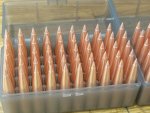We'd like to congratulate all the winners at the World's Longest Shot Challenge 'Quit Your Bitchin' ELR match this past weekend.
We'd also like to recognize the accomplishments that we were able to contribute to:
Winner of the 375 Class: David Mann shooting 400gr Flatlines in the 375 Warner cartridge!
John Baker was the only shooter to hit the 2650 yard target and he did it cold bore with a 256gr Flatline... yes that's a 338!
David Tubb kept the ELR Record in the Tubb family by going 3 for 3 at 2200 yards! David was shooting his 33XC with our new 285gr 338 Flatline.
Great Shooting Gentlemen!
We'd also like to recognize the accomplishments that we were able to contribute to:
Winner of the 375 Class: David Mann shooting 400gr Flatlines in the 375 Warner cartridge!
John Baker was the only shooter to hit the 2650 yard target and he did it cold bore with a 256gr Flatline... yes that's a 338!
David Tubb kept the ELR Record in the Tubb family by going 3 for 3 at 2200 yards! David was shooting his 33XC with our new 285gr 338 Flatline.
Great Shooting Gentlemen!
Last edited:



